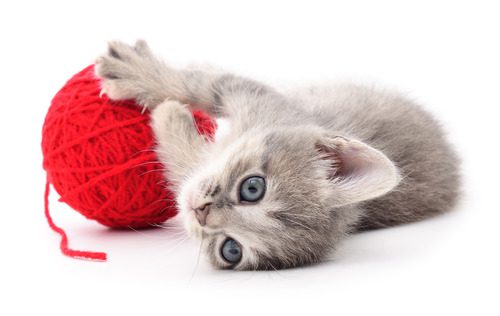My Cat Ate String. Now What?
Cats are known for their playful nature and curiosity. Sometimes, this curiosity leads them to ingest things they shouldn’t, like strings, ribbons, or yarn. This can cause various health issues for your feline if it’s not addressed promptly. If your cat ate string, it can be worrisome if you’re not sure how it affects their health. Try to stay calm and contact your primary veterinarian as soon as possible for what to do next. If you’re in Silver Spring, MD, and your pet requires emergency care or a specialty consultation, contact Apex Vets today.

What Are the Dangers of Cats Ingesting String?
String, ribbon, or yarn can get tangled in the digestive tract, causing blockages or tears. This can be life-threatening if not addressed promptly.
The Risk of Intestinal Blockage
One of the primary dangers of a cat eating string is the risk of an intestinal blockage. Strings can get lodged in various parts of the digestive tract, preventing food and waste from passing through. This blockage can lead to severe pain, vomiting, and dehydration.
Piercing the Intestinal Wall
When one end of the string gets wrapped around the base of the tongue or stuck in the stomach, the intestines may struggle to move the free end. This can cause the intestines to fold and make it impossible to pull the string out. If the string tightens, it can potentially pierce the intestinal walls, leading to severe complications.
Signs Your Cat May Have Eaten String
- Vomiting or gagging
- Loss of appetite
- Lethargy or decreased activity
- Abdominal pain or bloating
- Straining to defecate or lack of bowel movements
- Visible string protruding from the mouth or anus
What to Do If Your Cat Ate String
If you suspect or know that your cat ate string, here are the steps you should follow:
Contact Your Veterinarian
The first and most important step is to contact your veterinarian. Describe the situation and any symptoms your cat is experiencing. Your vet will guide you on whether you need to bring your cat in for an examination immediately or monitor them at home.
Do Not Pull the String
If you see a string hanging from your cat’s mouth or anus, do not attempt to pull it out. Pulling the string can cause further damage to the digestive tract, leading to more severe injuries. Leave the removal to the professionals who can do it safely.
Monitor Your Cat Closely
While waiting for veterinary advice or an appointment, monitor your cat closely. Keep an eye on their behavior, appetite, and bowel movements. Any changes or worsening symptoms should be reported to your vet immediately.
Veterinary Care and Treatment Options
When you take your cat to the veterinarian after they have ingested string, several diagnostic and treatment options may be considered.
Diagnostic Procedures
To determine the extent of the problem, your veterinarian may perform several diagnostic tests, including:
- Physical examination
- X-rays or ultrasound
- Blood tests
These tests will help the vet locate the string, assess any blockages, and check for internal injuries.
Treatment Options
The treatment your cat receives will depend on the location and severity of the string ingestion. Possible treatments include:
- Surgery: If the string has caused a blockage or internal damage, surgery may be necessary to remove it and repair any injuries.
- Supportive Care: In less severe cases, your vet may recommend monitoring your cat and providing supportive care, such as fluids and medications, to help them pass the string naturally.
Preventing Future Incidents
By taking some preventative measures, you can reduce the risk of recurrence.
Cat-Proofing Your Home
Keep strings, ribbons, yarn, and other small objects out of reach. Store these items in closed drawers or containers to ensure they are inaccessible to your cat. Additionally, be mindful of items like hair ties, rubber bands, and holiday decorations, as these can also pose a risk if ingested.
Providing Safe Toys
Providing your cat with safe and appropriate toys can help satisfy their playful nature and reduce the likelihood of them seeking out dangerous items. Opt for toys specifically designed for cats, made from materials that won’t break apart or pose a choking hazard. Regularly inspect toys for wear and tear, and replace them as needed to ensure they remain safe for your cat to play with.
Supervised Playtime
Engage in interactive play sessions using cat-safe toys, and always keep an eye on your cat when they are playing. This supervision allows you to intervene if they start chewing on or swallowing something they shouldn’t.
Training and Deterrents
Training your cat to avoid certain behaviors and using deterrents can also help prevent future incidents. For example, if your cat is particularly interested in strings or similar objects, you can use taste deterrent sprays on these items to make them less appealing. Additionally, providing positive reinforcement when your cat plays with appropriate toys can encourage them to stick to safe options.
When to Seek Emergency Care
Seek immediate veterinary attention if you notice any of the following signs:
- Persistent vomiting or gagging
- Severe abdominal pain or bloating
- Inability to eat or drink
- Visible distress or discomfort
Supporting Your Cat’s Recovery
Supporting your cat’s recovery after they have ingested a string involves providing them with a calm and comfortable environment. Follow your veterinarian’s instructions carefully and monitor your cat’s progress.
Post-Treatment Care
After treatment, your cat may need some time to recover fully. Ensure they have a quiet, safe space to rest and recuperate. Provide them with easy access to food, water, and a litter box. Follow any dietary or activity restrictions advised by your vet.
Regular Check-Ups
Schedule regular check-ups with your veterinarian to monitor your cat’s recovery and overall health.
Protecting Your Cat’s Health and Well-Being
Your cat is an important member of your family, and protecting their health and safety requires learning what to do in situations that may threaten their well-being. If you believe your cat ate string, contact your primary veterinarian and they can provide guidance on the next best steps. To prevent future incidents, keep all string, ribbon or yarn securely out of your cat’s reach and provide cat-friendly toys to play with under your supervision.
